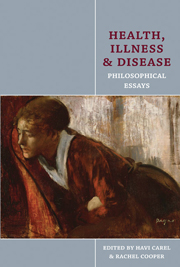Book contents
- Frontmatter
- Contents
- Acknowledgements
- Contributors
- Introduction
- Part I Concepts of health and disease
- Part II The experience of illness
- Part III Illness and society
- 9 Intersex, medicine and pathologization
- 10 Stigmatizing depression: folk theorizing and “the Pollyanna Backlash”
- 11 Doing health: a constructivist approach to health theory
- 12 Beauty and health as medical norms: the case of Nazi medicine
- Bibliography
- Index
9 - Intersex, medicine and pathologization
from Part III - Illness and society
- Frontmatter
- Contents
- Acknowledgements
- Contributors
- Introduction
- Part I Concepts of health and disease
- Part II The experience of illness
- Part III Illness and society
- 9 Intersex, medicine and pathologization
- 10 Stigmatizing depression: folk theorizing and “the Pollyanna Backlash”
- 11 Doing health: a constructivist approach to health theory
- 12 Beauty and health as medical norms: the case of Nazi medicine
- Bibliography
- Index
Summary
INTRODUCTION
In this chapter I examine a group of conditions that are included under the general heading of disorders of sex development, but which used to be called intersex conditions and, prior to that, hermaphroditism. Most of these conditions include atypical genital anatomy, frequently described as “ambiguous”, because it is not entirely typical of either sex. Much of what I discuss relates to congenital adrenal hyperplasia (CAH), which is the most common form of intersex and which is, therefore, one of the conditions in this group that is most frequently discussed in medical, sociological, psychological and ethical literature. In 2006, the term “disorder of sex development” was introduced into the medical literature, its use suggesting that all such conditions were within the remit of medicine (Spurgas 2009: 102). The new terminology took the place of the former and more neutral term “intersex”, a term that could be used outside the medical context (Long 2006). The change in nomenclature has proved a matter of some controversy, since not all of the people included in this category regard themselves as suffering from a medical disorder (see responses to Hughes et al. 2006). In this chapter I will use the term intersex.
Though for some writers, such as Boorse, disease is a matter of using statistical methods to identify the subnormal (1977: 543; 1997: 7–8) and, in most circumstances, does not involve value judgement, intersex conditions are important in that they provide an illustration of how, in practice, medicine relies heavily on social norms in deciding what constitutes “normal” or “abnormal” function. All biological characteristics are subject to variation, and this includes entities such as penile or vaginal length.
- Type
- Chapter
- Information
- Health, Illness and DiseasePhilosophical Essays, pp. 161 - 180Publisher: Acumen PublishingPrint publication year: 2012



